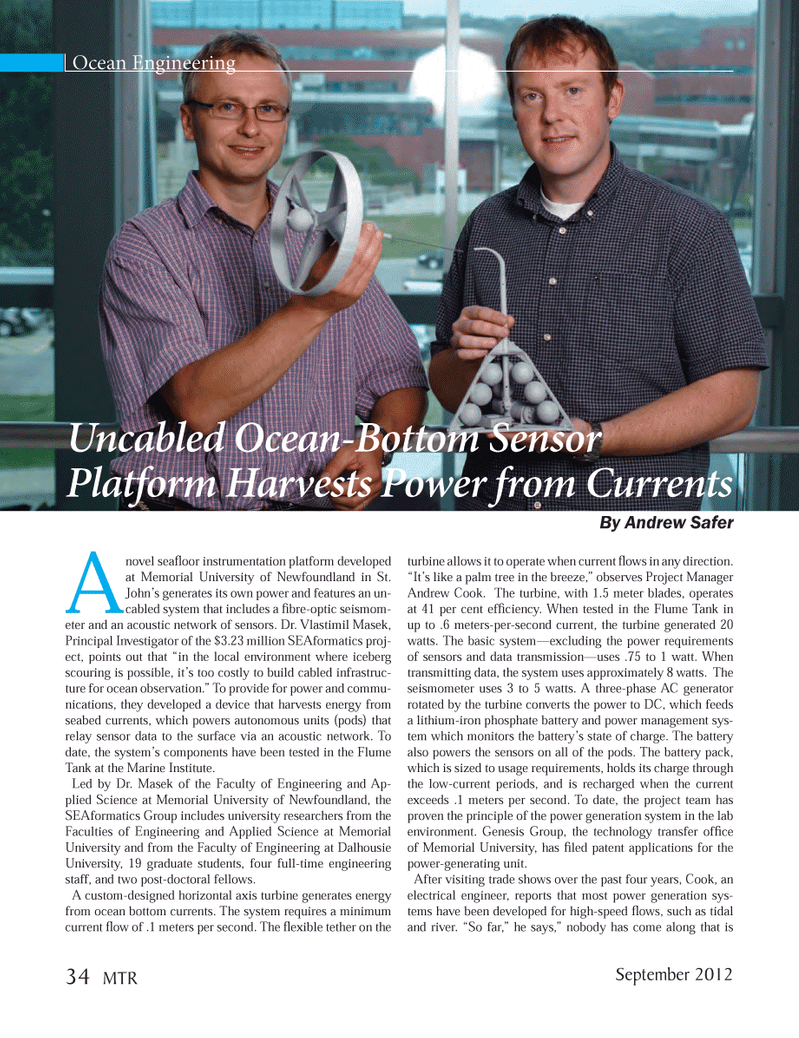
Page 34: of Marine Technology Magazine (September 2012)
Subsea Defense: Protecting Port & Subsea
Read this page in Pdf, Flash or Html5 edition of September 2012 Marine Technology Magazine
A novel seaß oor instrumentation platform developed at Memorial University of Newfoundland in St. JohnÕs generates its own power and features an un- cabled system that includes a Þ bre-optic seismom- eter and an acoustic network of sensors. Dr. Vlastimil Masek, Principal Investigator of the $3.23 million SEAformatics proj- ect, points out that Òin the local environment where iceberg scouring is possible, itÕs too costly to build cabled infrastruc- ture for ocean observation.Ó To provide for power and commu- nications, they developed a device that harvests energy from seabed currents, which powers autonomous units (pods) that relay sensor data to the surface via an acoustic network. To date, the systemÕs components have been tested in the Flume Tank at the Marine Institute. Led by Dr. Masek of the Faculty of Engineering and Ap- plied Science at Memorial University of Newfoundland, the SEAformatics Group includes university researchers from the Faculties of Engineering and Applied Science at Memorial University and from the Faculty of Engineering at Dalhousie University, 19 graduate students, four full-time engineering staff, and two post-doctoral fellows. A custom-designed horizontal axis turbine generates energy from ocean bottom currents. The system requires a minimum current ß ow of .1 meters per second. The ß exible tether on the turbine allows it to operate when current ß ows in any direction. ÒItÕs like a palm tree in the breeze,Ó observes Project Manager Andrew Cook. The turbine, with 1.5 meter blades, operates at 41 per cent efÞ ciency. When tested in the Flume Tank in up to .6 meters-per-second current, the turbine generated 20 watts. The basic systemÑexcluding the power requirements of sensors and data transmissionÑuses .75 to 1 watt. When transmitting data, the system uses approximately 8 watts. The seismometer uses 3 to 5 watts. A three-phase AC generator rotated by the turbine converts the power to DC, which feeds a lithium-iron phosphate battery and power management sys- tem which monitors the batteryÕs state of charge. The battery also powers the sensors on all of the pods. The battery pack, which is sized to usage requirements, holds its charge through the low-current periods, and is recharged when the current exceeds .1 meters per second. To date, the project team has proven the principle of the power generation system in the lab environment. Genesis Group, the technology transfer ofÞ ce of Memorial University, has Þ led patent applications for the power-generating unit. After visiting trade shows over the past four years, Cook, an electrical engineer, reports that most power generation sys- tems have been developed for high-speed ß ows, such as tidal and river. ÒSo far,Ó he says,Ó nobody has come along that is Ocean Engineering Uncabled Ocean-Bottom Sensor Platform Harvests Power from Currents By Andrew SaferSeptember 201234 MTRMTR #7 (34-49).indd 34MTR #7 (34-49).indd 349/10/2012 9:41:01 AM9/10/2012 9:41:01 AM

 33
33

 35
35
